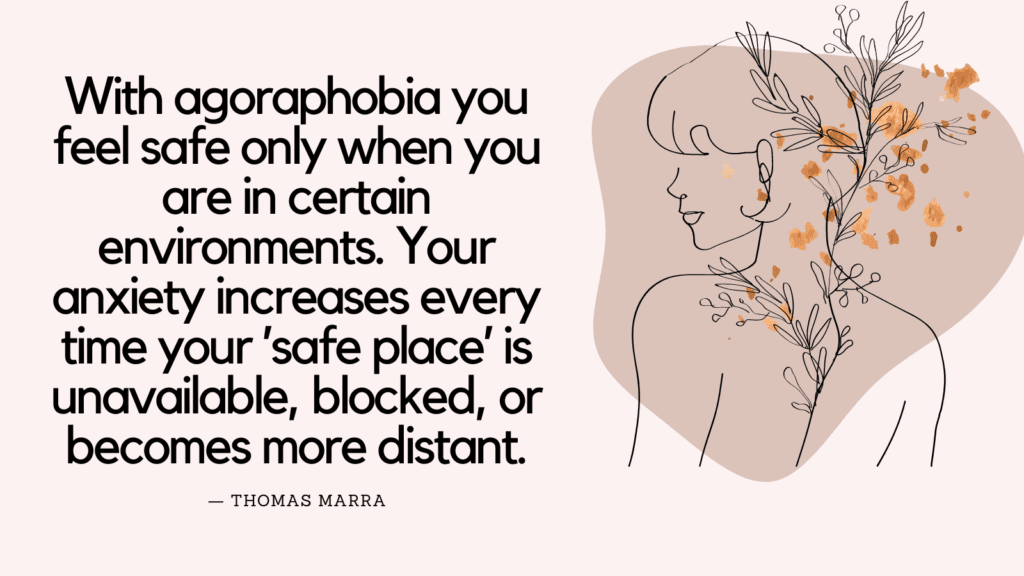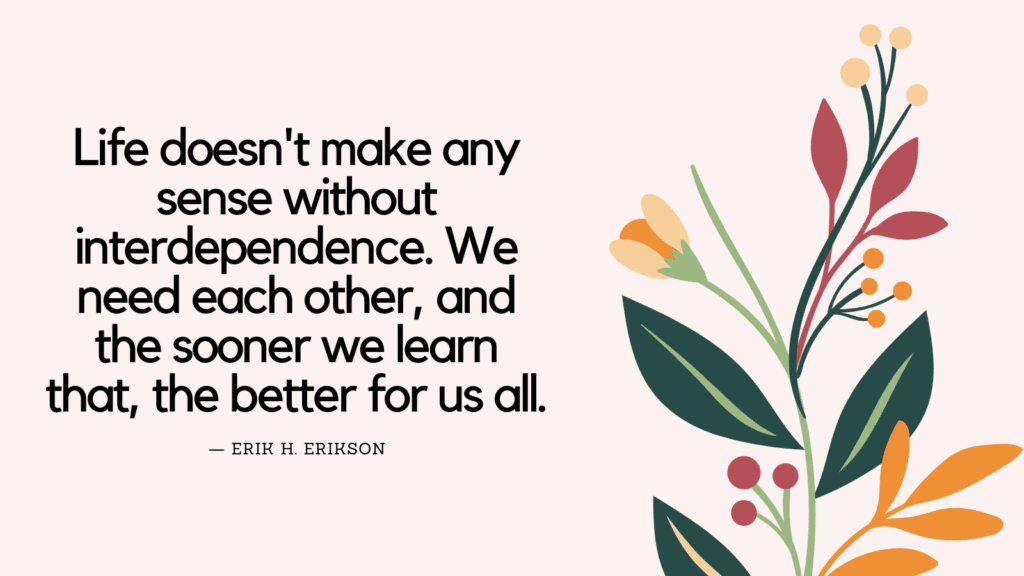This post contains some of the best agoraphobia quotes.
What Is Agoraphobia?
Agoraphobia is translated from the Greek, ‘a fear of the market place’.
Agoraphobia is a type of anxiety disorder in which you avoid places or situation that may cause you to panic
People who have had a panic attack in a public place may avoid that place for fear of having another attack.
The diagnostic and statistical manual of mental disorders, fifth edition, text revision (DSM-5-TR) defines agoraphobia as:
“A. Marked fear or anxiety about two (or more) of the following five situations:
- Using public transportation (e.g., automobiles, buses, trains, ships, planes).
- Being in open spaces (e.g., parking lots, marketplaces, bridges).
- Being in enclosed places (e.g., shops, theaters, cinemas).
- Standing in line or being in a crowd. 5. Being outside of the home alone.
B. The individual fears or avoids these situations because of thoughts that escape might be difficult or help might not be available in the event of developing panic-like symptoms or other incapacitating or embarrassing symptoms (e.g., fear of falling in the elderly; fear of incontinence).
C. The agoraphobic situations almost always provoke fear or anxiety.
D. The agoraphobic situations are actively avoided, require the presence of a companion, or are endured with intense fear or anxiety.
E. The fear or anxiety is out of proportion to the actual danger posed by the agoraphobic situations and to the sociocultural context.
F. The fear, anxiety, or avoidance is persistent, typically lasting for 6 months or more.
G. The fear, anxiety, or avoidance causes clinically significant distress or impairment in social, occupational, or other important areas of functioning.
H. If another medical condition (e.g., inflammatory bowel disease, Parkinson’s disease) is present, the fear, anxiety, or avoidance is clearly excessive.
I. The fear, anxiety, or avoidance is not better explained by the symptoms of another mental disorder—for example, the symptoms are not confined to specific phobia, situational type; do not involve only social situations (as in social anxiety disorder): and are not related exclusively to obsessions (as in obsessive-compulsive disorder), perceived defects or flaws in physical appearance (as in body dysmorphic disorder), reminders of traumatic events (as in posttraumatic stress disorder), or fear of separation (as in separation anxiety disorder).”
Related: How To Overcome Agoraphobia Without Medication? 9-Step Guide To Control Panic Attack In Public
Agoraphobia Quotes
1. “The person with agoraphobia will stay at home to prevent the possibility of an anxiety attack” – Derrick Silove & Vijaya Manicavasagar
2. “Common to all cases of agoraphobia is the belief that a symptom attack will lead to some catastrophic outcome.” – C.Alec Pollard & Elke Zuercher-White
3. “What all people with agoraphobia have in common is the fear of having a symptom attack, a sudden, intense rush of one or more internal sensations or physical symptoms, such as vomiting, headaches, or fainting.” – C.Alec Pollard & Elke Zuercher-White
4. “Overcoming anticipatory anxiety is one of the key elements in recovery from panic disorder and agoraphobia.” – Derrick Silove & Vijaya Manicavasagar
5. “Being housebound is the most severe form of agoraphobia. In fact, only a minority of people with agoraphobia are house bound. Many people have mild symptoms.” – C.Alec Pollard & Elke Zuercher-White
6. “A person suffering from agoraphobia tends to avoid situations in which escape might be difficult if they have a panic attack, or else tolerates being in that situation only with great dread or apprehension.” – Derrick Silove & Vijaya Manicavasagar
7. “If you need someone to be with you, even if you can do everything you like, you still can have severe agoraphobia. Relying on someone else for the rest of your life is a restriction imposed by fear. It leaves you dependent on others.” – C.Alec Pollard & Elke Zuercher-White
8. “The relationship between panic disorder and agoraphobia is complex. Quite a lot of people with panic disorder develop agoraphobia; but many do not, and they are referred to as suffering from ‘pure’ panic disorder.” – Derrick Silove & Vijaya Manicavasagar
Related: High Functioning Anxiety Test (& How To Support Anxiety Recovery)
9. “Agoraphobia also can persist after panic attacks have subsided. If a person who is worried about having a panic attack avoids all feared situations, they may thus prevent any further panic attacks; but the avoidance can continue and become an established way of life.” – Derrick Silove & Vijaya Manicavasagar
10. “Many people with agoraphobia are afraid to be alone, but not everyone is. Some people are more afraid when someone else is around because they are concerned about being embarrassed in front of others.” – C.Alec Pollard & Elke Zuercher-White
11. “People with agoraphobia are likely to become depressed because of their greatly restricted activities. In this way symptoms of anxiety, avoidance and depression interact to cause greater suffering and disability.” – Derrick Silove & Vijaya Manicavasagar
12. “While some people with agoraphobia fear crowds, others prefer them. Some people with agoraphobia feel that being around others provides a certain degree of safety.” – C.Alec Pollard & Elke Zuercher-White
13. “Often, people who have suffered from panic disorder and agoraphobia are more sensitive to other people’s distress and tension and better able to understand the difficulties and anxieties that others may experience.” – Derrick Silove & Vijaya Manicavasagar
Related: CBT For Phobias – Top 7 Phobias To Overcome For Good Using Cognitive Behavioral Therapy
14. “It is true that some agoraphobics avoid open spaces or public places, but many do not. When agoraphobics do fear situations, it is because of the threat of experiencing a sudden rush of sensations or symptoms, that is, a symptom attack.” – C.Alec Pollard & Elke Zuercher-White
15. “To recover from agoraphobia, you must face the situations you fear, eventually without any of your avoidant coping strategies. You may use distraction or other strategies to get through an exposure, and you may succeed at getting through the situation. But, remember, coping this way will not help you get better.” – C.Alec Pollard & Elke Zuercher-White
16. “Agoraphobia is a type of anxiety disorder in which you fear, and usually avoid, places or situations that might cause your anxiety levels to rise, often to the point of panic, or that make you feel trapped or helpless. The reaction to these places and/or circumstances may increase in number and intensity over time and become so strong and terrifying that you eventually avoid them completely. Ultimately you begin to avoid all outside situations for fear that you might have a reaction and you remain within the confines of your home or safe place. Finally, the mere anticipation of having an anxiety reaction or panic attack is enough to keep you from venturing out.” – Ellen Isaksen
17. “The word agoraphobia technically means fear of open spaces; however, the essence of agoraphobia is a fear of panic attacks. If you suffer from agoraphobia, you are afraid of being in situations from which escape might be difficult-or in which help might be unavailable-if you suddenly had a panic attack. You may avoid grocery stores or freeways, for example, not so much because of their inherent characteristics, but because these are situations from which escape might be difficult or embarrassing in the event of panic.” – Ellen Isaksen
18. “Fear of embarrassment plays a key role. Most agoraphobics fear not only having panic attacks but what other people will think should they be seen having a panic attack.” – Ellen Isaksen
19. “People with panic disorder often develop agoraphobia-the tendency to avoid places or situations where escape might be difficult or embarrassing or where help might be unavailable in the event of a panic attack.” – Ellen Isaksen
20. “If we look at agoraphobia, for instance, it’s not really a fear of open spaces or a fear of leaving one’s home. Agoraphobia is a severe enough fear of your anxiety symptoms that it gets you to change your life to avoid situations that you fear will trigger those symptoms. You’re not afraid of the world. You’re afraid of how you’ll feel in the world.” – Drew Linsalata
21. “Avoidance can also be hidden behind what looks like the exact opposite. The agoraphobic who “can’t” drive on the highway or go shopping decides to do these things, but with a safe person in tow. While this may look like forward progress, it is still avoiding to some degree. The driving and shopping are good. The safe person isn’t. This is hidden avoidance, masquerading as forward progress.” – Drew Linsalata
22. “An agoraphobic seeks safety in NOT doing. Avoiding and retreating.” – Drew Linsalata
23. “People with panic disorder or agoraphobia also often live with a constant background anxiety. Sometimes there is confusion in thinking that between panic attacks, people with panic disorder are anxiety-free. This is not true.” – Drew Linsalata
What’s Next? How To Overcome Agoraphobia Without Medication? 9-Step Guide To Control Panic Attack In Public
FREE Avoidance Worksheets

References
- Portions of this article were adapted from the book Diagnostic and Statistical Manual of Mental Disorders, Fifth Edition, Text Revision (DSM-5-TR), © 2021 by the American Psychiatric Association. All rights reserved.
- Portions of this article were adapted from the book Overcoming Panic And Agoraphobia, © 1997 by Derrick Silove & Vijaya Manicavasagar. All rights reserved.
- Portions of this article were adapted from the book The Agoraphobia Workbook, © 2003 by C.Alec Pollard & Elke Zuercher-White. All rights reserved.



